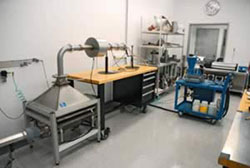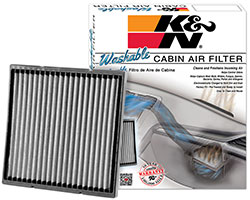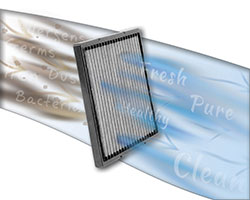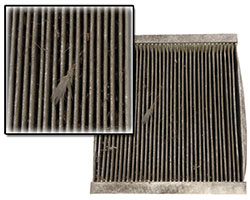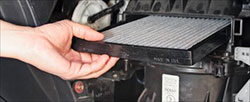Even Straight Out of the Car Wash, Your Car is Full of Pests Bent on Doing You Harm
- 29 sept 2016
Driving your car, truck, or SUV could make you sick, literally. Slipping into your vehicle every day are thousands of uninvited passengers like bacteria, dust, pollen, and other allergens, as well as particulate matter, any of which could trigger an allergic reaction or effect your long-term health. To protect yourself and your passengers from these miniature terrors, K&N has developed a line of cabin air filters designed to outperform standard paper cabin air filters. Saab was the first company to developed a cabin air filter for its cars, followed shortly thereafter by BMW and other European manufacturers like Audi. The European carmakers were the first to widely adopt cabin air filters, even in lower-priced cars like Seat and Volkswagen. In fact, it’s almost impossible to buy a car in Europe today that isn’t equipped with a cabin air filter. Mazda was the first of the Japanese brands to offer cabin air filters, but the other manufacturers quickly followed suit. Currently, Toyota installs cabin air filters in 100% of its new cars. The US car makers, tied-up with larger issues at the time, put off adopting cabin air filters, even though research at the time showed that 84% of American consumers surveyed would prefer their new vehicle come equipped with a filter in the cabin. The first cabin air filters appeared in American cars in the 1997 model year Buick Century and Regal as well as the Chevrolet Monte Carlo.
At this point, it’s difficult to find a new vehicle on a dealer’s lot that’s not equipped with a cabin air filter. And even vehicles that don’t feature a cabin filter often have the mounting hardware in place, so adding a filter can be a simple task. While having a cabin air filter installed in our car, truck, of SUV is beneficial to most of us, it’s critical for allergy sufferers. Consider Common Ragweed. Only about a handful of the microscopic spores of the prolific plant can trigger an attack in an allergy sufferer when seated in a closed car. K&N cabin air filters have been specifically engineered to help capture harmful and dangerous airborne particles such as spores, pollen, mildew, mold, fungus, and germs. They are also electrostatically charged so that they grab and hold onto passing dirt and dust. In fact, K&N cabin air filters comply with the rigorous ISO/TS 11155 international standard for cabin air filters as confirmed by the company’s own air filtration laboratory. Manufacturers vary in their cabin air filter replacement intervals, and many in the aftermarket call for a uniform 12,000-mile interval. Some of the more thorough types claim it’s best to change the filter twice a year, at the end of winter and at the end of summer. So what are the risks of not changing the filter as frequently as recommended, or even removing the filter altogether? We certainly don’t recommend either, and for good reason.
First, by not having a free-flowing source of incoming air, your air conditioning unit has to work that much harder, potentially shortening its service life. And no filter at all allows in unlimited amounts of large spore, pollen, bacteria, particulate or other nasties from outside the vehicle, into inside the vehicle. And if you think these containments will just blow straight through your vehicle, consider this: a Finnish study found that pollen grains were found in greater quantities on the dashboards of test cars than on the rear shelves. “These unexpected results could be partly explained by the fast and efficient attachment of pollen on the indoor surfaces,” the researchers wrote. So pollen is not blowing through your vehicle at all, but attaching itself to the first surface with which it comes in contact. Right where you and your front seat passenger are sitting. So there’s no getting around it. For the health of your passengers as well as that of the yourself, it makes perfect sense to keep a clean, operational cabin air filter in your vehicle’s HVAC (heating, ventilation, air conditioning) system. And if the thought of buying a $20 - $40 filter twice a year and having to for pay installation on top of that is of a concern to you, consider a washable, reusable K&N cabin air filter.
K&N cabin air filters are manufactured from a thermally-bonded nonwoven synthetic filter media, similar to that used as HVAC filters in hospitals and other healthcare facilities. Its molded urethane frame is designed to be a tight and secure replacement of your car’s original cabin filter, as it’s been test-fitted on different vehicles of the same year, make, and model. Best yet, the K&N cabin air filter is designed to replace your vehicle's stock cabin air filter with a washable and reusable version that’s intended to be cleaned and reused over and over again. So durable are these filters that they come with a 10 year/100,000 mile limited warranty. While most newer cars, SUVs, and light trucks come equipped with a cabin air filter, some older models may not. To determine if your vehicle has a cabin air filter, check your owner’s manual. Cabin filters are typically located in one of three places: under the hood near the windshield, underneath the dashboard, or behind the glove compartment. To determine if your car is equipped with one check out the K&N cabin air filter search. Most cabin air filters can be replaced without tools. However, some vehicles require a basic hand tool or two to open the filter compartment. Once a K&N cabin air filter has been installed you’ve pretty much eliminated the need to purchase and replace traditional cabin air filters for the life of your vehicle, with K&N’s 10 Year – 100,000 Mile Warranty.
The only maintenance needed is a service you can do yourself in just a short time. You should clean your K&N cabin air filter at recommended intervals of 12,000 miles (or less, if you drive on dusty roads or in areas with high pollen counts). To make it a simple and easy operation, utilize the K&N cabin air filter cleaning care kit. The cleaning kit comes with two bottles: one is a 12-ounce pump spray of cabin filter cleaner, which not only loosens dirt and road grime from your filter but also removes trapped mold, mildew, fungus, allergens, bacteria and other debris from the filter. The second bottle is an 8-ounce pump spray bottle of cabin air filter refresher, which revives the electrostatic properties of the cabin air filter, recharging the filter so it can snatch dust and dirt particles out of the airstream. Based on 50 years of records and core samples that date back to the Stone Age, Dutch researchers have concluded that “global climate changes will likely affect the intensity of the pollen season” due to increases in carbon dioxide in the atmosphere. So if you noticed a greater presence of pollen over the last year or two, it’s predicted to be part of an ongoing trend. So clearly the car makers are on the right track by installing cabin air filters in their vehicles. And you can take better care of yourself and your passengers by ordering a K&N cabin air filter for your car, truck, or SUV today. To find additional K&N upgrades for cars, trucks, semis, karts, scooters, motorcycles, motorhomes, or almost anything with an engine, use the K&N search by vehicle tool. You can also find an authorized K&N dealer nearby using the K&N dealer search tool. |
||||||
|
||||||

